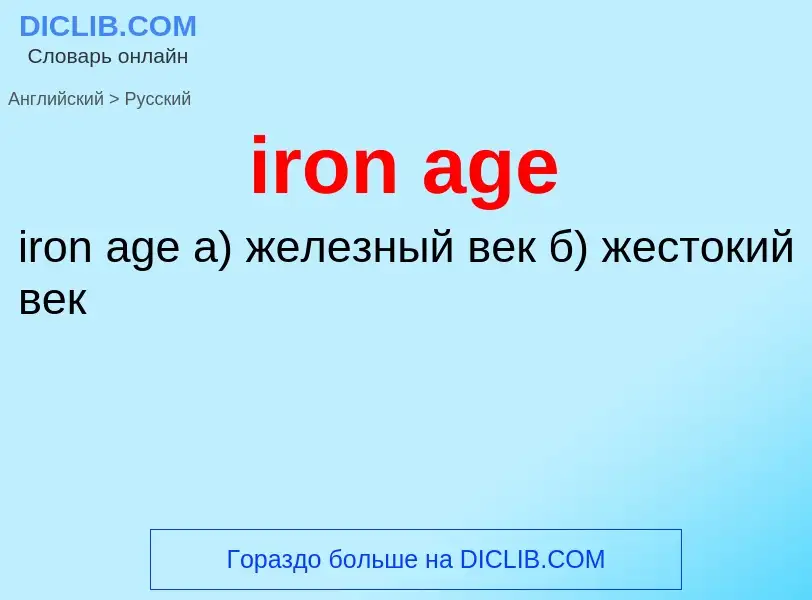Перевод и анализ слов искусственным интеллектом ChatGPT
На этой странице Вы можете получить подробный анализ слова или словосочетания, произведенный с помощью лучшей на сегодняшний день технологии искусственного интеллекта:
- как употребляется слово
- частота употребления
- используется оно чаще в устной или письменной речи
- варианты перевода слова
- примеры употребления (несколько фраз с переводом)
- этимология
Iron Age - перевод на Английский
['aiəneidʒ]
общая лексика
"железный век"
так в американской литературе именуется период истории вычислительной техники от 1961 г., когда появился первый миникомпьютер (PDP-1), до 1971 г, - времени создания первого коммерческого микропроцессора (Intel 4004). Это был период господства занимавших громадные залы мэйнфреймов
Железный век
Смотрите также
общая лексика
железный век
жестокий век
Определение
Википедия
The Iron Age is the final epoch of the three-age division of the prehistory and protohistory of humanity. It was preceded by the Stone Age (Paleolithic, Mesolithic, Neolithic) and the Bronze Age. The concept has been mostly applied to Iron Age Europe and the Ancient Near East, but also, by analogy, to other parts of the Old World.
The duration of the Iron Age varies depending on the region under consideration. It is defined by archaeological convention. The "Iron Age" begins locally when the production of iron or steel has advanced to the point where iron tools and weapons replace their bronze equivalents in common use. In the Ancient Near East, this transition took place in the wake of the Bronze Age collapse, in the 12th century BC. The technology soon spread throughout the Mediterranean Basin region and to South Asia (Iron Age in India) between the 12th and 11th century BC. Its further spread to Central Asia, Eastern Europe, and Central Europe is somewhat delayed, and Northern Europe was not reached until around the start of the 5th century BC.
The Iron Age is taken to end, also by convention, with the beginning of the historiographical record. This usually does not represent a clear break in the archaeological record; for the Ancient Near East, the establishment of the Achaemenid Empire c. 550 BC is traditionally and still usually taken as a cut-off date, later dates being considered historical by virtue of the record by Herodotus, despite considerable written records from far earlier (well back into the Bronze Age) now being known. In Central and Western Europe, the Roman conquests of the 1st century BC serve as marking for the end of the Iron Age. The Germanic Iron Age of Scandinavia is taken to end c. 800 AD, with the beginning of the Viking Age.
In the Indian sub-continent, the Iron Age is taken to begin with the ironworking Painted Gray Ware culture. Recent estimates suggest that it ranges from the 15th century BC, through to the reign of Ashoka in the 3rd century BC. The use of the term "Iron Age" in the archaeology of South, East, and Southeast Asia is more recent and less common than for Western Eurasia. In China, written history started before iron-working arrived, so the term is infrequently used.


![[[Silla]] chest and neck armour from the [[National Museum of Korea]] in [[Seoul]] (3rd century AD) [[Silla]] chest and neck armour from the [[National Museum of Korea]] in [[Seoul]] (3rd century AD)](https://commons.wikimedia.org/wiki/Special:FilePath/Korea-Silla-Iron.armor-01.jpg?width=200)
![ithyphallic]] [[warrior]] made of [[sandstone]], the oldest known Iron Age life-size anthropomorphic statue north of the [[Alps]] ithyphallic]] [[warrior]] made of [[sandstone]], the oldest known Iron Age life-size anthropomorphic statue north of the [[Alps]]](https://commons.wikimedia.org/wiki/Special:FilePath/Krieger von Hirschlanden.jpg?width=200)

